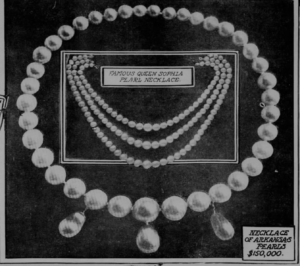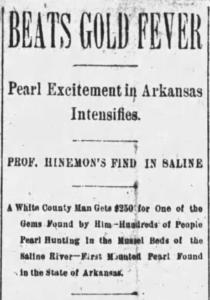In the 1850s, a New Jersey shoemaker found a large pearl inside a mussel pulled from a New Jersey river. The valuable pearl was sold to Tiffany & Co. for $1500. The find inspired others to scour freshwater rivers and lakes, hoping to find more gems. The hunt for pearls moved south, and in the early 1880s, more pearls were discovered in Arkansas. The discovery set off the Arkansas pearl rush which produced more than $2.5 million in pearls annually before the mussel population began to dwindle around 1905.
It was the discovery of a large pearl in 1897 that fueled the Arkansas pearl rush. Dr. J. Hamilton Meyers found a large, valuable pink pearl in a mussel shell from the Black River. News of the discovery spread, and people flocked to the lakes and rivers, hoping to make a similar find. Makeshift settlements popped up along the rivers as men, women, and children joined the search. Newspapers compared the frenzy to the Klondike Gold Rush. The mussels were abundant, and pearl hunters gathered them by hand in shallow waters. Those lucky enough to find a pearl inside discovered gems in many colors, including white, pink, blue, purple, and black. The pearls were prized by jewelers and some even became part of a royal gem collection.
Single pearls could command a premium price if they met the specifications a jeweler required to form a matched string of pearls or earrings. One Arkansas pearl buyer recalled selling a single pearl to a French jeweler for $1,500. It was the final pearl needed to complete a necklace. The finished string of pearls had a value of $200,000!
The pearl rush also gave birth to a robust shell button industry. In the late 1890s, thousands of mussel shells were shipped by rail from Arkansas to Iowa, where button factories turned them into beautiful mother-of-pearl buttons. By 1900, button factories were operating in Arkansas, popping up along northeastern Arkansas rivers. Factory workers gathered mussel shells and placed them in hot water to open them. They removed the meat, graded the shells, and then cut them into button blanks. By the end of WWII, plastic buttons put most shell button factories out of business.
Overharvesting led to a dwindling mussel population in Arkansas, and by 1905, pearls were much harder to find. Shells were no longer available in shallow waters and pearl hunters relied on boats and special tools like long-handled tongs called pearling rakes to search in deeper waters. About the same time, cultured pearls were also making their way into U.S. markets. A Japanese man, Mikimoto Kokichi, had patented a new process of injecting a grain of sand or ground mussel shell into an oyster, forcing the oyster to form a pearl. Cultured pearl jewelry became popular and much more accessible.
Does someone in your family have a piece of jewelry that contains Arkansas pearls? If you would like to learn more about the Arkansas pearl rush, search Newspapers.com™ today!
Like this post? Try one of these:





I really enjoy Newspapers.com and have found a lot of relevant info. I would like to make a request for more Newton County Arkansas newspapers, especially those in and around Jasper. I have many ancestors and relatives from this area and would really like more info about them. Sloan and Kilgore descendants will thank you!
I agree. I have many ancestors in that area including the old town of Carver on the Buffalo river.
My Uncle James Peach has the largest collection of fresh water pearls in the country that came out of the Arkansas and Ft. Gibson lake in Wagoner Oklahoma he bought in the late 70’s early 80’s. They were plentiful the lakes have a turnover about every 20 years. Beautiful pink and black pearls.
Classic example of over exploiting a good thing and destroying a resource. All fueled by the desire of people seeking high social status by the things they “own” that are essentially of no other real value. Consider the difference in demand for a mother of pearl button (useful) to the “perfect” matched set pearl necklace.
How many thousands of meals could have been provided to the underprivileged for the price just one expensive vanity pearl necklace!
So true!
The images of people captured in the photo of pearl hunters do not appear to be over privileged.
Individually and collectively, without forced servitude, charity or the force of government, they found a way to furnish their own meals.
Excellent Dave , I agree with you
The people seeking high status fueling the depletion of the mussel beds are the ones buying the finished jewelry.
I loved hearing about how it al started. We are so used to going to the store and buying what we want.
I had never heard of the Pearl Rush. Great story! The 200K string of pearl was likely purchased by someone who wouldn’t send the money to the thousands who lived off the pearl industry. The Arkansas clams are more endangered today by dams, pollution, construction, invasive species than harvesting of the past. Of what intrinsic value are professional sports? To me less than a piece of jewelry which also has close to no value to me. At least you can hold jewelry in your hand. How do you justify the salaries of these athletes? The many jobs associated with the sport industry. What people WANT is unfortunately what will continue to run the world economies. People prioritize their hair, nails, internet, clothing, eating out, and cell phones every day over their doctor, dentist, education or other more justified expense. The minute basic needs of food and shelter are met, 99% of humans want more. Attempts to make it otherwise have a poor track record. George Orwell said it well in Animal Farm: “All animals are equal but some are more equal than others”
That is today’s world totally not something I can understand.
Women have children and give them up in 6-8 weeks to go back to work. Why? Why did they have children?
So they can afford a bigger house, newer car, luxury vacations etc. they don’t have a clue
Women have children because they want. They go to work to support them.
It is easier to afford luxury vacations, new cars and bigger houses when you don’t have more mouths to feed and diapers to change. It is certainly easier to go on those luxury vacations when you don’t have school schedules to work around. New cars look nicer without cheerios on the floor and little handprints on the windows. No one has kids so that they can afford more things. Having kids is an expense, but they are worth it.
Not every household can get by on one income. Sometimes both parents need to work. Sometimes the mom is the only parent. I suspect amany moms go back to work so that their children owon’t go hungry and they will continue to have a roof over htheir hheads
What does that have to do with the pearl business.
My father’s father & mother’s family came from there. My grandparents were children then. I wonder if any o their families “rushed”.
I have a black necklace, one strand of Mikimoto pearls that my husband bought in Japan when he was in the U.S.Navy years ago.
In the 1900 census My Great Grand Father’s occupation was button cutter. His name was Earl Finley 1881- 1954 in their button factory in Andalusia, Il. I have no pearls. But have the mussel shells with holes where the blanks were cut out. Also packages of the buttons.
Great story!! I love to hear about these things, it seems that these great histories of the past have been lost today. Thank you for the great info. Would love to hear more personal histories about the pearl rush and I wonder how does one tell if their pearl came from Arkansas or were synthetically produced?
There was a substantial shell button production from the Arkansas River which was a major factor in reducing the mussel population. Some of my great aunts from Johnson county had shells and buttons processed there. Plastic came along and replaced the more expensive shell buttons.
I’m from Muscatine, Iowa. At one time the pearl capital of the world and where many of the railroad cars would have been headed. A piece of art done by my great grandfather is on display at the pearl button museum in Muscatine.
It’s weird how comments are turned off on each article that’s older then the current one.
It really feels like an Operation Grid X Part II but with comments:
Having more 2021 content on papers doesn’t really help us to see history.
How about a story on the Indiana gas boom – similar story of boom, waste and decline?
So amazingly cool … This site is a wealth of information. I pray there is never sensor editing. In the time of the early 1900s it was a chronological listing of most of my family member’s historical but specific events that had gone out the window with our fallible memories. It links directly to some DNA sites which also is a ‘minesweep’ of information.
So how would one know if they had an Arkansas pearl, do they look any different than other pearls?